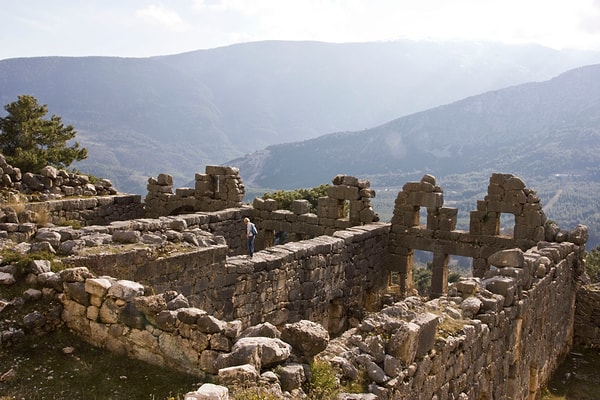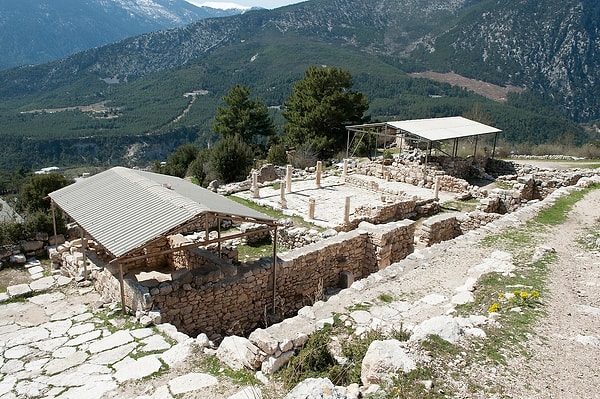Arykanda Ancient City Travel Guide: Discover Lycian Ruins in the Heart of Antalya
Arykanda Ancient City, built on the foothills of the Taurus Mountains within the borders of the Finike district of Antalya, is one of the rare examples of the Lycian civilisation that fascinates its visitors with its unique location intertwined with nature and the periods it has gone through throughout history. This ancient city, whose name comes from Arykawanda, which means “near the high cliffs” in Lycian, is an open-air museum for archaeology enthusiasts and nature lovers.
Historical Depths of Arykanda

The history of Arykanda dates back to the 2nd millennium BC. Although it was first mentioned in written documents within the Lycian Union in the 5th century BC, archaeological excavations in the city show that the settlement dates back much earlier. Arykanda, which was actively used in the Roman and Byzantine periods, was abandoned due to earthquakes and migrations over time.
In the city, which prospered during the Roman period, architectural structures were highly developed. The buildings in the city are considered among the most successful examples of Lycia in terms of stone workmanship, planning and harmony with the natural topography.
Mythological and Cultural Importance

Arykanda is one of the cities that carries the spirit of the Lycian civilisation. The burial traditions, ties with the gods and architectural symbols of Lycian culture can be clearly seen in this city. Although not directly mythologically associated with a god or goddess, the temples and altars found in the city reveal that Arykanda played an important role in religious life.
As in most Lycian cities, traces of the cults of Apollo, Artemis and Leto can be found here. At the same time, ancient tomb inscriptions reveal the religious aspect of Arykanda with votive inscriptions dedicated to the city's dignitaries and gods.
Must-See Historical Structures in Arykanda

The ruins of the ancient city are very well preserved and were built in terraces on the slope of a mountain. As you walk through the city, you will come across many buildings from different periods:
Theatre: This theatre, belonging to the Roman period, attracts attention with its 20 steps and a capacity of 1000 people. It is positioned against the view.
Stadium: The 170-meter-long stadium is one of the rare examples in Lycia. It was used for athletics competitions.
Bath Complex: This building, which bears traces of Roman architecture, draws attention with its floor heating systems. The niches in the walls can still be seen.
Agora: The agora, the social and economic centre of the city, is surrounded by a columned courtyard.
Tombs and sarcophagi: Rock tombs carved into terraces and sarcophagi with inscriptions are important examples of Lycian burial culture.
Odeon: It is a small 100-seat theatre and was used for meetings or musical events.
Places to Visit Around Arykanda

There are other historical and natural beauties that you can add to your route after your Arykanda trip:
Limyra Ancient City: Located only 10 km from Finike, this ancient city is a Lycian settlement that flourished in the same period as Arykanda.
Gagai Ancient City: Located on the borders of Kumluca, it is more difficult to reach, but can be reached with a walk in nature.
Gökbük Canyon: Close to Arykanda, this canyon is an excellent alternative for hiking and cooling off.
Finike Beaches: An ideal spot to reach the cool waters of the Mediterranean after a historical tour.
How to get to Arykanda?

Arykanda Ancient City is located within the borders of Arif village of Finike district of Antalya. Coming by private car is the most practical method. It takes about 35 minutes (27 km) from the centre of Finike to Arykanda. It is possible to reach Arykanda from Antalya city centre with a journey of approximately 2.5 hours (150 km).
For those who prefer public transportation, you can take the buses from Antalya to Finike and then take a taxi or local shuttle service to Arykanda. However, since the city is located in a mountainous region, it is important to wear shoes suitable for hiking.
Arykanda Visit Information

The ancient city is open to visitors every day of the week, and the Museum Card is valid at the entrance. Different visiting hours may apply in summer and winter, so it is worth checking the current information of the Antalya Museum Directorate before going.
The entrance fee is quite reasonable and it can be observed that the area is regularly protected. It is especially recommended to visit in the morning, as the climbing paths can be difficult in the heat of the afternoon.
What to do in Arykanda?

After visiting the ancient city, you can take a nature walk, meet the locals in the surrounding villages and buy natural products. You can find organic olive oil, honey and goat cheese in and around Arif village.
In addition, the surroundings offer very suitable areas for campers and nature photographers. Especially in spring and fall, hiking among the flower-covered hills is an unforgettable experience.
When to Visit?

Although Arykanda can be visited at any time of the year, the best times to visit are spring (April-June) and autumn (September-October). The weather is neither too hot nor too rainy, and nature is a visual feast of greenery and colourful flowers that blend with the ancient buildings. These seasons are ideal for photography, hiking and exploring history.
In summer, especially in July and August, temperatures can reach over 35°C, so it is recommended to plan your visit for early morning. This way, you will avoid the risk of heatstroke and you will have the opportunity to visit without the crowds.
In winter, the weather can be cool and rainy at times. However, since the region is under the influence of the mild Mediterranean climate, it is not completely closed. However, since the ground can be slippery from time to time, care should be taken and appropriate shoes should be preferred.
Keşfet ile ziyaret ettiğin tüm kategorileri tek akışta gör!

Send Comment